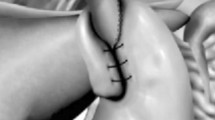Abstract
Background
Large paraesophageal hernias are notoriously difficult to manage via laparoscopy and are associated with a significant recurrence rate. A novel laparoscopic approach was used to close the diaphragmatic defect in four patients diagnosed with large, paraesophageal hernias and gastroesophageal reflux disease symptomatology.
Methods
All procedures were performed via laparoscopy. Three patients underwent a reduction of the paraesophageal hernia with a Nissen fundoplication and one with Collis-Nissen fundoplication. Standard crural closure was performed over a #60 Fr Bougie in two patients, and two patients did not undergo a cruroplasty. In all four patients, the left hepatic lobe was freed, repositioned, and anchored under and inferior to the gastroesophageal junction, propping the gastroesophageal junction anteriorly. This maneuver entirely covers and closes the diaphragmatic defect.
Results
Postoperatively, all patients did well without notable, unusual complaints. Average length of stay was 2 days. Although not statistically significant, all patients had no recurrence of symptoms or of their paraesophageal hernia at 8, 9, 11, and 15 months after the procedure.
Conclusions
In selected patients, large paraesophageal hernias can safely be managed via a laparoscopic antireflux procedure with the hepatic shoulder technique. Although no long-term follow-up is available, this technique has shown good early postoperative results and may be used as an alternative to a laparoscopic Mesh reinforced fundoplication or difficult crural closure.




Similar content being viewed by others
References
Hashemi MP (2000) Laparoscopic repair of large type III hiatal hernia: objective follow-up reveals high recurrence rate. J Am Coll Surg 190:553–560
Stirling MC, Orringer MB (1986) Surgical treatment after the failed antireflux operation. J Thoracic Cardiovasc Surg 92:667–672
Carlson MA, Frantzides CT (2001) Complications and results of primary minimally invasive antireflux procedures: a review of 10, 735 reported cases. J Am Coll Surg 193:428–439
Frantzides CT, Madan AK, Carlson MA, Stavropoulos GP (2002) A prospective, randomized trial of laparoscopic polytetrafluoroethyene (PTFE) patch repair vs simple cruroplasty for large hiatal hernias. Arch Surg 137:649–651
Huntington T (1997) Laparoscopic mesh repair of the esophageal hiatus. J Am Coll Surg 182:397–400
Trus TL, Bax T, Richardson WS et al (1997) Complications of laparoscopic paraesophageal hernia repair. J Gastrointest Surg 1:221–228
Edelman D (1999) Laparoscopic paraesophageal hernia repair with mesh. Surg Laparosc Endosc 2:360–363
Granderath FA, Kamolz T, Schweiger UM, Pointner R (2006) Impact of laparoscopic Nissen fundoplication with prosthetic hiatal closure on esophageal body motility. Arch Surg 141:625–632
Zilberstein B, Eshkenazy R, Pajecki D, Granja C, Brito AC (2005) Laparoscopic mesh repair antireflux surgery for treatment of large hiatal hernia. Dis Esophagus 18:166–169
Quilici PJ et al (2003) The use of mesh re-enforced laparoscopic Nissen fundoplication. SAGES Presentation, Los Angeles
Author information
Authors and Affiliations
Corresponding author
Rights and permissions
About this article
Cite this article
Quilici, P.J., McVay, C. & Tovar, A. Laparoscopic antireflux procedures with hepatic shoulder technique for the surgical management of large paraesophageal hernias and gastroesophageal reflux disease. Surg Endosc 23, 2620–2623 (2009). https://doi.org/10.1007/s00464-009-0452-0
Received:
Revised:
Accepted:
Published:
Issue Date:
DOI: https://doi.org/10.1007/s00464-009-0452-0




